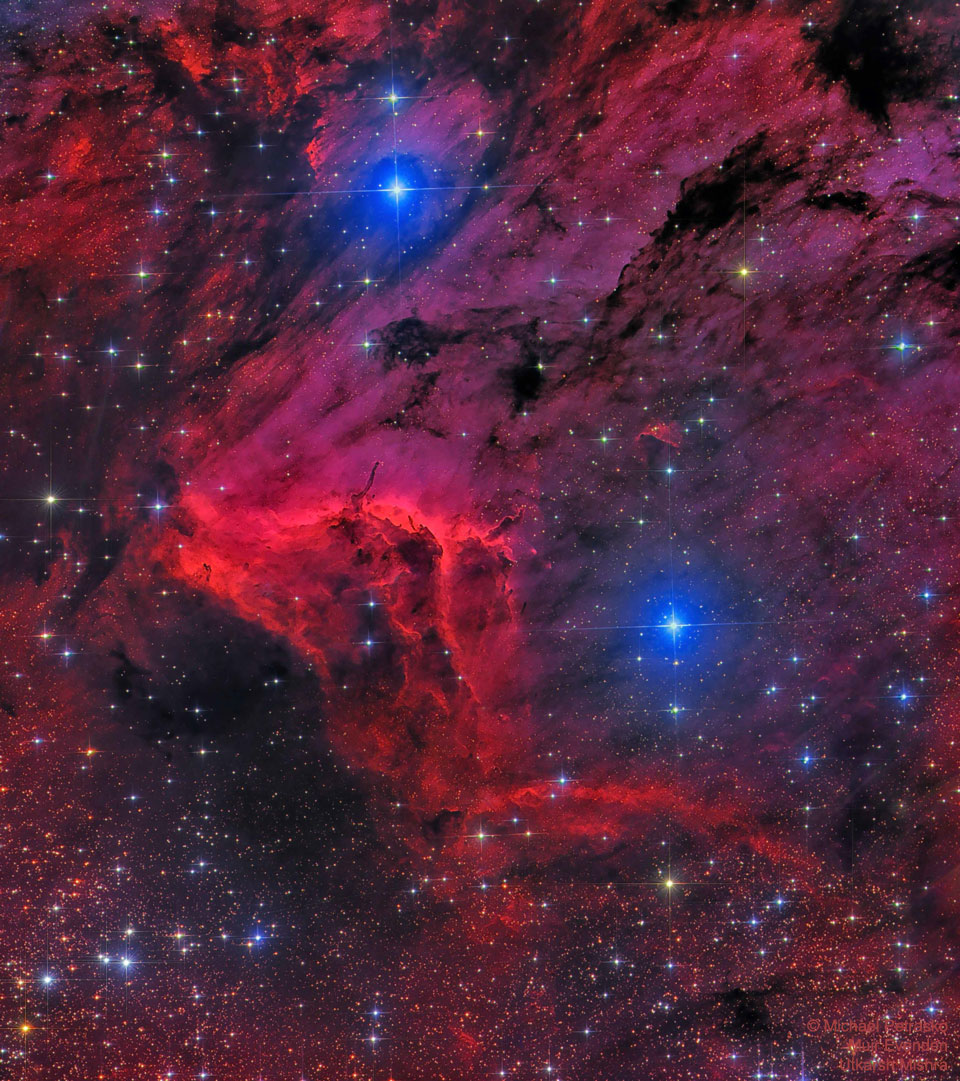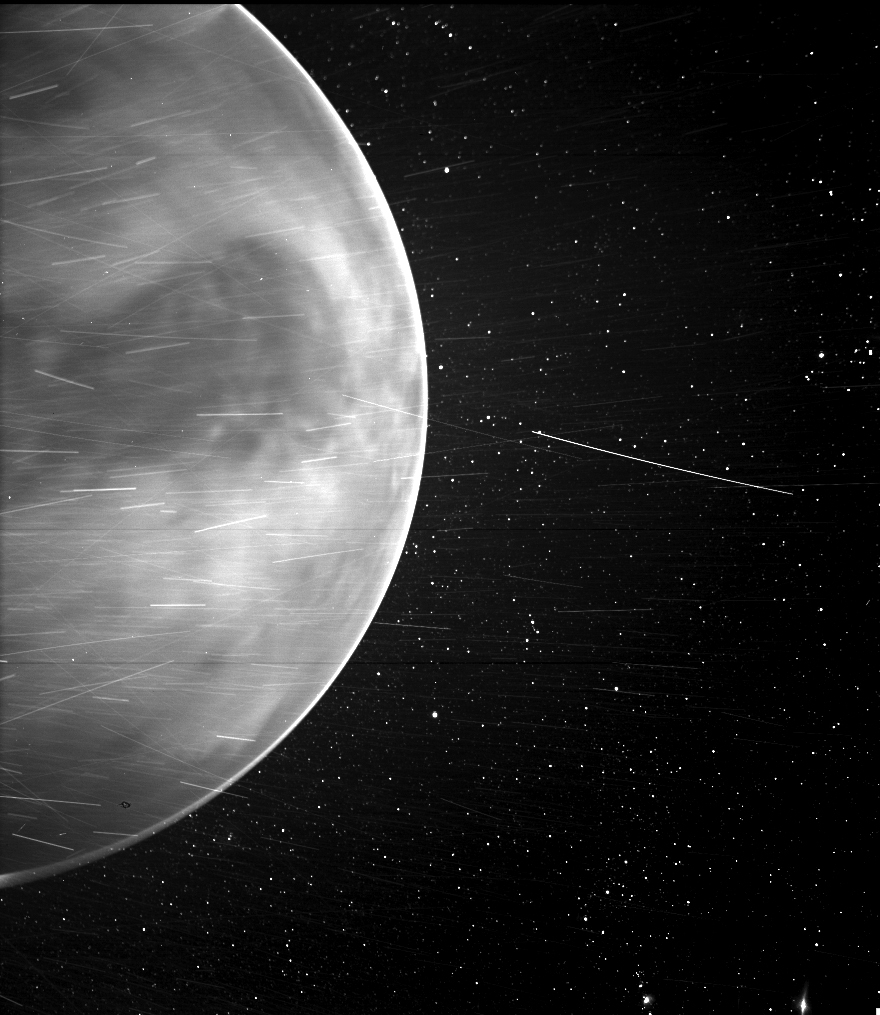Nombre total de pages vues
02/03/2021
ASTRONOMY - Ingenuity: A Mini-Helicopter Now on Mars
2021 March 2
Illustration Credit: NASA, JPL-Caltech, Mars 2020 - Perseverance
Explanation: What if you could fly around Mars? NASA may have achieved that capability last month with the landing of Perseverance, a rover which included a small flight-worthy companion called Ingenuity, nicknamed Ginny. Even though Ginny is small -- a toaster-sized helicopter with four long legs and two even-longer (1.2-meter) rotors, she is the first of her kind -- there has never been anything like her before. After being deployed, possibly in April, the car-sized Perseverance ("Percy") will back away to give Ginny ample room to attempt her unprecedented first flight. In the featured artistic illustration, Ginny's long rotors are depicted giving her the lift she needs to fly into the thin Martian atmosphere and explore the area near Perseverance. Although Ingenuity herself will not fly very far, she is a prototype for all future airborne Solar-System robots that may fly far across not only Mars, but Titan.
01/03/2021
ASTRONOMY - The Pelican Nebula in Red and Blue
Image Credit & Copyright: M. Petrasko, M. Evenden, U. Mishra (Insight Obs.)
Explanation: The Pelican Nebula is changing. The entire nebula, officially designated IC 5070, is divided from the larger North America Nebula by a molecular cloud filled with dark dust. The Pelican, however, is particularly interesting because it is an unusually active mix of star formation and evolving gas clouds. The featured picture was processed to bring out two main colors, red and blue, with the red dominated by light emitted by interstellar hydrogen. Ultraviolet light emitted by young energetic stars is slowly transforming cold gas in the nebula to hot gas, with the advancing boundary between the two, known as an ionization front, visible in bright red across the image center. Particularly dense tentacles of cold gas remain. Millions of years from now this nebula might no longer be known as the Pelican, as the balance and placement of stars and gas will surely leave something that appears completely different.
28/02/2021
ASTRONOMY - The Aurora Tree
2021 February 28
Image Credit & Copyright: Alyn Wallace
Explanation: Yes, but can your tree do this? Pictured is a visual coincidence between the dark branches of a nearby tree and bright glow of a distant aurora. The beauty of the aurora -- combined with how it seemed to mimic a tree right nearby -- mesmerized the photographer to such a degree that he momentarily forgot to take pictures. When viewed at the right angle, it seemed that this tree had aurora for leaves. Fortunately, before the aurora morphed into a different overall shape, he came to his senses and capture the awe-inspiring momentary coincidence. Typically triggered by solar explosions, aurora are caused by high energy electrons impacting the Earth's atmosphere around 150 kilometers up. The unusual Earth-sky collaboration was witnessed in March of 2017 in Iceland.
26/02/2021
DESCOBERTAS CIÊNCIA - A pilha voltaica
ASTRONOMIE - Un cratère géant rempli de glasse immortalisé sur Mars
Un cratère géant rempli de glasse immortalisé sur Mars
ASTRONOMY - Mars Perseverance Sol 3
2021 February 26
Image Credit: NASA, JPL-Caltech, MSSS, ASU
Explanation: Stitched together on planet Earth, 142 separate images make up this 360 degree panorama from the floor of Jezero Crater on Mars. The high-resolution color images were taken by the Perseverance rover's zoomable Mastcam-Z during mission sol 3, also known as February 21, 2021. In the foreground of Mastcam-Z's view is the car-sized rover's deck. Broad light-colored patches in the martian soil just beyond it were scoured by descent stage rocket engines during the rover's dramatic arrival on February 18. The rim of 45 kilometer-wide Jezero Crater rises in the distance. In the coming sols, Perseverance will explore the ancient lake-delta system in the crater, hunting for signs of past microscopic life and collecting samples for potential future return to planet Earth.
25/02/2021
ASTRONOMY - A Venus flyby
2021 February 25
Image Credit: NASA, JHUAPL, Naval Research Lab, Guillermo Stenborg and Brendan Gallagher
Explanation: On a mission to explore the inner heliosphere and solar corona, on July 11, 2020 the Wide-field Imager on board NASA's Parker Solar Probe captured this stunning view of the nightside of Venus at distance of about 12,400 kilometers (7,693 miles). The spacecraft was making the third of seven gravity-assist flybys of the inner planet. The gravity-asssist flybys are designed to use the approach to Venus to help the probe alter its orbit to ultimately come within 6 million kilometers (4 million miles) of the solar surface in late 2025. A surprising image, the side-looking camera seems to peer through the clouds to show a dark feature near the center known as Aphrodite Terra, the largest highland region on the Venusian surface. The bright rim at the edge of the planet is nightglow likely emitted by excited oxygen atoms recombining into molecules in the upper reaches of the atmosphere. Bright streaks and blemishes throughout the image are likely due to energetic charged particles, and dust near the camera reflecting sunlight. Skygazers from planet Earth probably recognize the familiar stars of Orion's belt and sword at lower right.
24/02/2021
ASTRONOMY - Spiral Galaxy M66 from Hubble
2021 February 24
Image Credit: NASA, ESA, Hubble, Janice Lee; Processing & Copyright: Leo Shatz; Text: Karen Masters
Explanation: It’s always nice to get a new view of an old friend. This stunning Hubble Space Telescope image of nearby spiral galaxy M66 is just that. A spiral galaxy with a small central bar, M66 is a member of the Leo Galaxy Triplet, a group of three galaxies about 30 million light years from us. The Leo Triplet is a popular target for relatively small telescopes, in part because M66 and its galactic companions M65 and NGC 3628 all appear separated by about the angular width of a full moon. The featured image of M66 was taken by Hubble to help investigate the connection between star formation and molecular gas clouds. Clearly visible are bright blue stars, pink ionized hydrogen clouds -- sprinkled all along the outer spiral arms, and dark dust lanes in which more star formation could be hiding.
ASTRONOMY - The Observable Universe
2025 November 23 The Observable Universe Illustration Credit & Licence : Wikipedia , Pablo Carlos Budassi Explanation: How far can ...

-
2022 September 26 All the Water on Planet Earth Illustration Credit: Jack Cook, Adam Nieman, Woods Hole Oceanographic Institution ; Data ...
-
2025 May 11 The Surface of Venus from Venera 14 Image Credit: Soviet Planetary Exploration Program , Venera 14 ; Processing & Copyri...








